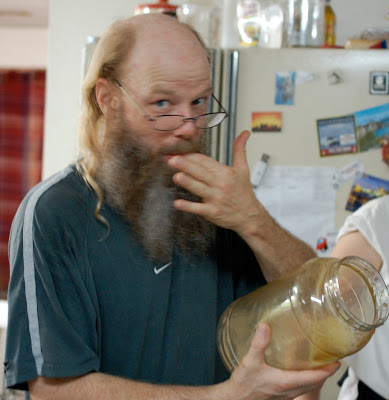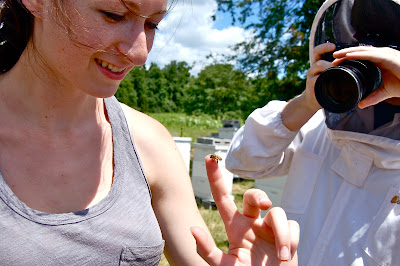It gives me great pleasure to write this post, because it has three things I love in this world: family, food, and photography.
Every couple of years, my family (both biological and extended) brews mead. It is a drink of fermented honey (sometimes labeled “honey wine”) found throughout Europe, Asia, and in some parts of Africa over a period of eight thousand years. To us, like our ancestors of which we take precedence, we view it as sacred work. It is a craft that requires all to assist, from sanitizing the five-gallon carboys to measuring out the honey and water ratio to pouring in the yeast and mixing it all together. This year was our largest batch yet: forty-five gallons of newly made mead. And after nine months, it will be ready to bottle.
Now, before everyone gets excited, we cannot distribute mead for the purpose of making money, as we are not legally certified to do so. We make it for personal consumption and to share with friends at our monthly get-togethers. Those who take part are of drinking age and drink responsibly as stated in U.S. law. Plus, should you wish for a taste of what we refer as “The Drink of the Gods”, by all means brew your own. I am personally hoping to create a gluten free honey beer this summer, a recipe I will most certainly share with you all. This post, on the other hand, is to share the experience of making mead, with the permission of everyone involved… oh, and share a honey-based recipe to follow.
I love honey. It is my sweetener of choice besides naturally sweet foods and pure stevia. Before my family started brewing, I thought the only honey flavors out there were clover, wildflower, and buckwheat. But oh no, there is so much more variety than that. For our brewing purposes on Saturday, we used the following: wildflower, avocado, killer bee (which tasted like grape), and Scottish heather. They not only differ in color, but in consistency and taste. We purchased our honey from The Bee Folks (they also sell mead making kits) in one-gallon containers as well as a whopping five-gallon bucket from the Amish farm we buy from once in a while. Just imagine: nine gallons of honey for nine carboys. This particular batch is likely to last us for five years at least.
And of course we had sticky fingers from tasting the leftover honey.
Every couple of years, my family (both biological and extended) brews mead. It is a drink of fermented honey (sometimes labeled “honey wine”) found throughout Europe, Asia, and in some parts of Africa over a period of eight thousand years. To us, like our ancestors of which we take precedence, we view it as sacred work. It is a craft that requires all to assist, from sanitizing the five-gallon carboys to measuring out the honey and water ratio to pouring in the yeast and mixing it all together. This year was our largest batch yet: forty-five gallons of newly made mead. And after nine months, it will be ready to bottle.
Now, before everyone gets excited, we cannot distribute mead for the purpose of making money, as we are not legally certified to do so. We make it for personal consumption and to share with friends at our monthly get-togethers. Those who take part are of drinking age and drink responsibly as stated in U.S. law. Plus, should you wish for a taste of what we refer as “The Drink of the Gods”, by all means brew your own. I am personally hoping to create a gluten free honey beer this summer, a recipe I will most certainly share with you all. This post, on the other hand, is to share the experience of making mead, with the permission of everyone involved… oh, and share a honey-based recipe to follow.
I love honey. It is my sweetener of choice besides naturally sweet foods and pure stevia. Before my family started brewing, I thought the only honey flavors out there were clover, wildflower, and buckwheat. But oh no, there is so much more variety than that. For our brewing purposes on Saturday, we used the following: wildflower, avocado, killer bee (which tasted like grape), and Scottish heather. They not only differ in color, but in consistency and taste. We purchased our honey from The Bee Folks (they also sell mead making kits) in one-gallon containers as well as a whopping five-gallon bucket from the Amish farm we buy from once in a while. Just imagine: nine gallons of honey for nine carboys. This particular batch is likely to last us for five years at least.
And of course we had sticky fingers from tasting the leftover honey.
Along with honey, I love the beings that make it: the bees. When I was part of the Benjamin Franklin Summer Institute of South and Central Asia, some of the kids who didn’t have host families for the week spent the weekend in a beautiful home where Environmental Studies on the Piedmont is located. I came up for the day to hang out with the kids and learn all about bees and beekeeping.
And maybe I was giving off acceptable pheromones or maybe it was my respect for these small sentient beings, but I was not afraid and I didn’t get stung once. There is nothing quite like honey straight from the hive, and chewing on warm honeycomb like gum. I had more respect of where an important source that is essential to living comes from, and I hope humanity works toward helping the bee population grow to its utmost potential.
Four hours of grueling work meant a hungry group of people. As I was in charge of the menu, I was inspired to put honey in everything. I made a simple salad dressing of grapeseed oil, lemon, and honey, which was also used as a glazed for the salmon. Honey liquor was used to marinate the chicken. And finally, honey took part in making an amazing pie.
I was first inspired to make a coconut “cream” pie when five pounds of dehydrated coconut pieces came to my door from Essential Living Foods. (I also ordered coconut nectar sugar, which comes from the blossom and not the palm.) I gave a little under a pound to a good friend of mine, but I still have enough to last me quite a few recipes in the future. Seriously, the bag is the size of a baby, so if you have any recipes you think I should use them in please leave a comment below.
Four hours of grueling work meant a hungry group of people. As I was in charge of the menu, I was inspired to put honey in everything. I made a simple salad dressing of grapeseed oil, lemon, and honey, which was also used as a glazed for the salmon. Honey liquor was used to marinate the chicken. And finally, honey took part in making an amazing pie.
I was first inspired to make a coconut “cream” pie when five pounds of dehydrated coconut pieces came to my door from Essential Living Foods. (I also ordered coconut nectar sugar, which comes from the blossom and not the palm.) I gave a little under a pound to a good friend of mine, but I still have enough to last me quite a few recipes in the future. Seriously, the bag is the size of a baby, so if you have any recipes you think I should use them in please leave a comment below.
Chocolate Coconut Custard Pie (inspired from this amazing recipe)
1/2 of Morri’s pie crust recipe
Butter, for greasing the pie pan
4 Large eggs
640 ml Canned coconut milk
105 g Honey
1 1/2 tsp. Bourbon vanilla
1/2 tsp. Sea salt
15 g Cocoa powder, sifted
50 g Raw dehydrated coconut flakes
Preheat the oven to 425ºF.
Roll out the pie dough on a lightly floured surface until formed into a large flat circle, about one-eight of an inch thick.
Transfer the dough into a greased nine-inch pie pan and smooth the edges (you are not likely to have leftover dough scraps).
Evenly lay out the dehydrated coconut pieces on the bottom and set aside.
In a large mixing bowl, combine the eggs, coconut milk, honey, vanilla, salt, and cocoa powder with an electric mixer until thoroughly integrated.
Pour the custard into the pie pan and bake for 15 minutes.
Decrease the temperature to 350ºF for an additional 40 – 45 minutes, or until the center has firmed slightly.
Take out of the oven to cool on the counter-top until room temperature (at least three to four hours), and then place in the fridge to chill (at lease three to four hours).
Serve chilled with whipped cream, ice cream, and coffee.
Makes 8 – 16 servings, depending on the size of the slices.















No comments:
Post a Comment